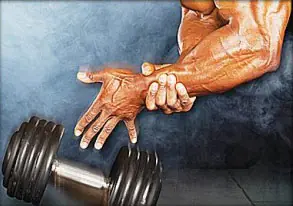Muscle strain occurs when overload, and also when excessive tension muscle tissue or ligaments. This most often occurs due to intense training, not corresponding to real possibilities, and also with overly active and sudden movements or when training without warming up and warming up the muscles. This is a painful sensation that feels like something inside is bursting or tearing when the ligaments are stretched too far. The consequences of muscle strain are not the most pleasant and harmless. You may not even be able to walk or move fully, but over time this will all be correctable. The treatment period, depending on the severity, takes from 1 to 6 weeks.
Some muscle tissues are capable of significant stretching, and sometimes they can even tear. Hyper-stretching of muscle fibers also qualifies as muscle rupture, since recovery cannot be done without surgery. Otherwise, the muscle will not completely restore its functions, and in the future your movements will be limited, and you can completely forget about “iron sports”. So, if you are more or less lucky and you get a simple sprain, then on the damaged area you will notice tumor and, perhaps, bleeding. Over time, as the stretching wears off, it may develop scars. Unfortunately, the muscle is no longer so strong and elastic. When sprained, ligament tissues are torn, as well as other elements that help the joints. With strong tension they become very sensitive and weak.
How can you help yourself?
The first step is to work on the bleeding stopped and the swelling subsided. The treatment methods are quite simple:
- For at least the first two days, relieve yourself of the load in the area of the damaged muscle, and then avoid sudden movements and re-injury.
- Ice should be applied as soon as possible after injury. To begin with, at least half an hour. And for two days, while the stretched muscle is at rest, ice should be applied every 4-5 hours. Ice packs are perfect for this purpose, perhaps just cubes wrapped in a napkin or a towel moistened with cold water. If you don’t have all this on hand, look in the freezer for frozen vegetables, meat, or anything else of that kind. But remember that you cannot simply apply ice to the site of injury, as this can cause frostbite to the tissue. This must be done through fabric.
- Apply a compressive elastic bandage to the area where the muscle is sprained.
- If you have injured a limb, arm or leg, then the most convenient and useful way is to have it elevated during treatment, at least for the first few days.
- Apply warm compresses to the sprained area. Stretch this muscle with gentle movements, such as while taking a hot bath.
- Start warming up and stretching the damaged muscle every day, doing 10 exercises. Avoid sudden jolts and jerks. All movements must be smooth and soft, otherwise you can harm yourself even more.
- But not doing it is very dangerous. Classes should be regular, with a gradual increase in approaches.
- If you have injured your leg, try not to limp when walking. It is better to slow down the pace of movement, and if necessary, use a support or a cane.
- Try to restore the stretched muscle to its former elasticity and strength. Develop special exercises. When playing sports, use a special elastic bandage.
What can a doctor do to help with a sprain?
He can use injections, freezing or other medications to reduce pain and reduce swelling. Well, of course, you cannot do without it in case of a severe injury, as well as in the case when you are inexperienced and cannot determine your degree of sprain yourself. After all, perhaps you could get a break. In this case, it is necessary to contact a sports orthopedist, who will most likely offer an x-ray of the injured area in order to diagnose the integrity of the joint, ligaments and bone. Perhaps seek the services of a physiotherapist. But still, most minor injuries can be treated on their own, provided that the above recommendations are followed.
Post Views: 100


